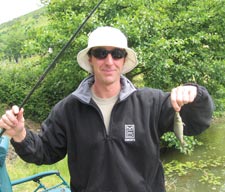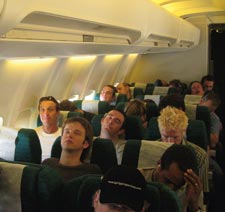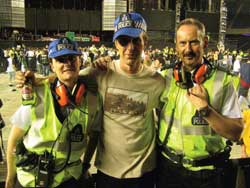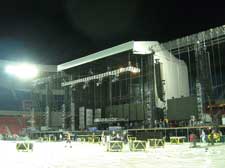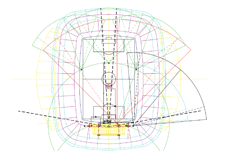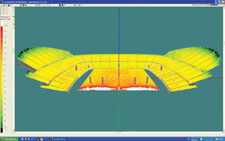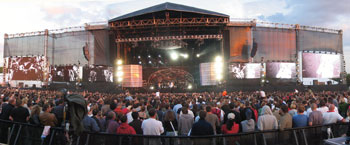
Consistency With Limitations - Part
III
The saga continues. Possible incarceration?
Read the whole saga: Part 1, Part 2, Part 4
The intrepid author continues to detail the goal of overall goal of sonic consistency while heading up sound on a 14-date tour across Europe with the Red Hot Chili Peppers
|
|
Day 8, Wednesday – Vienna, Austria: Just pondering the show
yesterday. Sound limits can be very frustrating – I’m not sure exactly
what the limits were, but I recall something about 92 dB and 98 dB.
(92 averaged over the entire show and 98 averaged over the set is what
I think I heard someone say.)
Does not matter much. I feel that I faired exceptionally well considering
the parameters, partially due to approach and partially due to pure
luck. I always make a point of meeting, talking to and taking interest
in the SPL-monitoring humans at every show where they’re working.
The SPL guy in Milan was cool; I ran into him backstage after line check
while trying to make my way back to the hotel and avoid sitting at the
venue for three hours until the next runner/shuttle. He found a spare
helmet and gave me a ride on his scooter to the Metro station. (Must
admit that flying through Italian traffic not only scared the crap out
of me, it was the best part of my day.)
At show time, two songs in, and we’re at 102 dB. This means I need two
songs at 94 dB to get back to the 98 dB average. Yikes! I’m already
starving for more volume as it is.
There had already been more than a few radio calls the day before about
noise limits, signing contracts, financial penalties and all that wonderful
stuff. If only the audience would shut up - they were pushing past my
98 dB limit between songs.
Then it happens - the computer for SPL monitoring overheats, and the
super-cool “sound cop” simply gives me the international palms-up sign
for “oh well.” We go on to see what 350 loudspeakers can really do,
even though only a mere 100 or so are pointed in my general direction.
The system configuration:
- Four main PA clusters consisting of 16 V-DOSC and six dV-DOSC each
- 54 SB 218 subwoofers
- Nine primary delay clusters of nineV-DOSC and six dV-DOSC each
- Nine secondary delay clusters of nine dV-DOSC and two dV-Subs each
For me, mixing a stadium is about as fun and exciting as it is for a
fighter pilot to steer a luxury liner. Challenging, yes, but mostly
in a big, slow, lumbering way. Huge backlash delays, not only from the
seats but also from delay clusters hitting seats, with sound then traveling
all the way back. Direct sound and stereo imaging are wonderful things
to imagine.
There is something to be said for volume, though. I know there are issues
with loud and hurting ears, but there are also issues with water/drowning,
snowboarding/broken bones and driving cars/crashing. Drag races are
loud - really loud - they put us rock show people to shame in the loud
category.
On the flip side, fast and loud provides a thrill, a rush and excitement
(or fear, depending on your age and life experience). Loud is a matter
of opinion, and when that SPL computer stopped working, it was clear
that the opinion of 60,000 Italians was pretty much unanimous that a
bit louder was a lot better.
Day 9, Thursday – Vienna, Austria (show day): Festival with the
Pixies on right before us! One of my favorite bands!! Today is more
of a standard festival setup, and as long as we don’t get a repeat of
last night’s wind/dust/thunder/rain storm, it should all be good.
|
|
The main challenge I face today is boredom. Without a proper place
to work, the nine-hour time change and blasting metal bands coming from
all directions, being productive is a battle not worth fighting. This
is my biggest issue with touring - being trapped, far away, and keeping
a steady flow of interesting things in my day.
A very important facet I’m continuing to address is subwoofer coverage.
It’s amazing that it is considered acceptable to have a tremendous low-frequency
peak creating a power alley for the sound engineer, with greatly reduced
low-end coverage off to the sides.
For all of the technology and effort taken to cover the audience with
smooth, even sound, why are subwoofer coverage issues not more seriously
addressed?
Our subwoofer design template for this tour is based on a five-point
system. The general theory is to create multiple “power alleys.” Placing
the outside subs farther upstage increases the coverage pattern. The
center fill is run at a lower volume and just fills in the hole right
up front and center.
I was a bit unprepared for the lack of understanding about this setup,
so the “no delays will be needed” had to be quickly revised: individual
vendors, site plans and conventional thinking all conspired to severely
limit our ability to put the outside subs sufficiently upstage for most
shows.
To resolve this, we added delay to the outside sub clusters, which helped
further increase the coverage to the sides. When properly positioned,
increasing level and/or delay time to outside clusters widens the low-frequency
coverage. Meanwhile, increasing level/delay time to the center cluster
can reduce some central holes/peaks down the middle.
Tomorrow’s another travel day, and it’s also my birthday. Will it be
a happy one?
Day 10, Friday - Vienna to Dublin (fly day): Happy birthday to
me! I’m 42 years old today. Last year on my birthday, in the midst of
a U.S. Peppers tour, I called ahead to have a van pick up Scott the
Lampi and I at the tour busses parked in front of the New Orleans gig.
Went fishing all day on the Bayou for red fish. This year I’m dead tired
on an overcrowded plane flight. Awesome!
|
|
Last night’s show (in Vienna) was stronger, the band seemed to be having
more fun and the audience was happy. Yet the thought that I’m just a
“glorified carney” (carnival worker) crosses my mind.
Day 11, Saturday - Dublin, Ireland (show day): Nearly 120,000
people today. I heard something about it being some kind of capacity
record but won’t risk being corrected by guessing.
Everything has become fairly predictable. Noise limits were reasonable,
and lots of happy Irish. To me it felt like any good-sized field/park
gig with the exception that I had to hike a hell of lot farther to listen
to the three waves of delay clusters.
I must say that having good techs that are able to match the sound of
the delays to the mains, is unbelievably important. Also, having delay
cabs that match the mains, as we do, is vital.
Day 12, Sunday - Edinburgh, Scotland (show day): Following an
overnight bus ride, I arrive to actually get a decent line check. Wow,
good stuff!
Probably one of my least favorite parts of touring is long bus rides,
or worse, catching the 6 am ferry in mid bus ride. Once again I’m faced
with the choice of sleeping in a sealed bus locked in the belly of an
ocean bound ferry or wandering aimlessly around the deck after being
jolted awake by our bus driver shouting, “Everybody off the bus!” This
time I hide in my bunk, close my eyes, cross my fingers and try my best
to sleep through the creepy echoing boat belly ride.
Good-looking gig today, the shows continue to pick up momentum. It seems
directly related to the crews’ lack of sleep and road weariness. Just
like re-starting an exercise routine - the initial traumas are beginning
to fade and we seem to be adapting and settling in.
Day 14, Tuesday - Paris, France (show day): Ah, the refreshing
sensation of having a show that feels right, with the synchronization
of the band, video, lights and sound right on.
The other shows have been good, with highlights of their own, but this
is the first gig of the run where everything has totally fallen into
place. It’s important to keep in mind, however, that my perspective
is severely tilted after 20 years of seeing the Peppers play and mixing
nearly every show for the past 15 years.
|
|
The idea of carrying processors and “mirror image” PA systems is living
up to my expectations. Each show has been a progressive build on the
last; rather than hoping the system is going to be O.K., my confidence
is building. Unfortunately, this is our last show with the Pixies.
Issues to be addressed:
- Guitar “down” the vocal microphone - ever since the band went to in-ear
monitoring (IEM) systems, the delicate balance of guitar volume/tone
has progressively gotten more difficult to deal with. Guitar bleed into
the vox mics has reached a level that is sometimes unmanageable.
- Something is glitchy with the drum machine track CD used for The Zephyr
Song.
- Deal with the recording levels for the live two-track machines.
- See how the “VIP fill” system on the stage wing, is working. The feed
to this system is the same as the recording two-track, with the whole
mix plus two stage audience mics. We added the fills soon after the
band went on IEM so that friends and people on stage could hear a proper
mix.
Day 15, Wednesday - Amsterdam (show day): Other than the self-pity
of having to mix in a chamber of sonic hell, the show was really cool.
Tonight I believe we may have set a record for the lowest note ever
created from a trumpet. Flea plays trumpet as the intro to the encore,
and John (Frusciante, guitarist) runs this feed through some guitar
effects. I took some liberties with a sub-synthesizer. It was good fun,
and having trumpet “blur vision” is a new experience.
Besides mixing in the giant echo chamber, I had further concerns when
presented with a rather ominous memo/warning sheet for the show. At
the venue, there are 24 sensors mounted below the two-story-high stadium
floor, and due to structural concerns, the memo told us:
Point #1: If any sensor reads “1 meter per second, squared” then house
sound will be turned down 6 dB and video close-ups disallowed on the
screens.
Point #2: If any sensor reads “2 meters per second, squared” then house
sound will be turned down an additional 6 dB and video turned off.
And so on up to Point #6, where we were warned that police would be
brought in to make things “better.” By that point, I felt it necessary
to determine (in catering of course) what is actually meant by “1 meter
per second, squared,” in the real world. Assuming “1 meter per second’
works out to be 3,600 meters per hour, it means an acceleration of a
bit over 2 miles per hour.
So I did the math and if at any point, the venue is moving 2 miles an
hour faster than it was before, then “Houston, we have a problem!” The
memo also clearly stated that both low-frequency energy and synchronized
audience jumping could potentially cause my potential incarceration.
Day 16, Thursday - Manchester, U.K. (travel day): Unplugging
the top guitar cabinets worked out really well. For some reason, guitar-bleed
into John Frusciante’s mic has been worse this tour. We tried moving,
redirecting and turning down the cabs - finally I requested that they
be unplugged. There was also an IEM issue as well, with the guitar “jumping
up” when John steps away from the mic.
The results of the unplugging went beyond my expectation; not only did
it resolve the issue of me needing to ride the vocal mic from 200 feet
away, but also, the rig sounds better and the band is happier with the
IEM sound.
We burned new CDs for the Zeyphr drum machine track, yet it was still
faulty. Turned out to be the CD player - it’s one of those cool Sony
single rack-space vari-speed units. Switched to the spare unit, and
all seems good, although we won’t know for sure until they play the
song again.
Day 17, Friday - Manchester, U.K (show day): The first rock gig
at the new Manchester Stadium. The roof opening looks like a giant potato
chip (Pringles variety to be more exact). It’s something like 50 meters
(about 150 feet) high on the sides, and with dual-tiered balconies.
It was a tough space to cover but the system designer, Flo (Radiohead
FOH tech), did a superb job. Originally we were trying to make system
coverage decisions based on photos and 2-D drawings, but that was rough.
When Flo ran the room with the new 3-D Soundvision software, it all
came together and worked very well.
Day 18, Saturday - London, U.K. (show day 1): The “Big Kahuna”
of the tour - 85,000-plus tickets sold for each of three shows. Additionally,
there will be recording done on these shows for a live Peppers album.
|
|
I can feel the pressure and anticipation of both the crew and band.
Everyone is pushing that extra bit to guarantee perfection.
For me, it’s all about noise limits. The system is the same, the shows
are coming up nearly the same, but noise restrictions change everything.
Rumor has it that last year, nearby wealthy residents offered 1 million
pounds (about $2 million U.S.) to have the bands not play in the venue.
So, there’s a lot of audio measurement going on and much concern for
the powerful residents.
Today’s show went fine, but I felt a bit strangled by the noise limits.
It’s a matter of staying focused on the aspects I actually have control
over. Crappy sounding rooms, noise restrictions and inadequate trim
height are just challenges to overcome. No use crying about it.
Working with U.K. touring company Britannia Row, we came up with the
following to increase sound for the audience (and me) while maintaining
a positive off-site situation. (Only two complaints so far!)
- Lower trim height for the main loudspeakers.
- More down-tilt to reduce sound reflecting off of the audience.
- Reduce delay cluster volumes which point at measurement mics off site.
Day 19, Sunday - London (show day 2): Laptop dead - aarrgghhh!
Well, it’s running now, but it was dead earlier. No booting, and an
operating system crash… Not going to dive into the nuances of this computer
meltdown here, but in order to get it running, I did the following (after
trying everything else).
- Panicked. Well, not really, but could feel the welling sense of dread
slowly rising inside me.
- Disassembled laptop and removed the hard drive.
- Disassembled MP3 player and removed the hard drive.
- Borrowed dual rectangle USB cable from Scott the Lampi.
- Plugged MP3 Player with my laptop hard drive into (system tech) Nick
the Fly’s laptop with Scott’s cable.
- Prayed to the “computer gods” that “plug and play” did not mean “plug
and then go search for drivers on the Internet.”
- Found the file named “system” and replaced it with the “system-alt”
file that I found nearby. (When it crashed, my computer had blamed that
specific file.)
- Took it all apart and re-assembled.
- Closed my eyes and hit the power button.
Celebration! All is good, the computer lives - no data loss and I’m
back to life as a functioning human again. The show rocked, plenty of
volume, the noise meters off-site measured 2 dB lower and all seemed
good.
Then comes the post-show report: “20 vociferous noise complaints.” And
we still have one more show here next week. Oh jeez, this is not good.
“What are we going to do to solve the issue?” I’m asked. Not exactly
sure at this very moment, but I can predict many “meetings” with “very
concerned” people.
Join Dave Rat, who heads up Rat Sound, based in California, as he
continues this discussion with us. By the way, if you have comments
or questions for Dave, he will be monitoring the Rat Sound message board
@ http://www.ratsound.com/wwwboard/wwwboard.shtml
